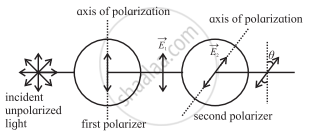Advertisements
Advertisements
Question
Answer in brief:
Explain what is meant by polarization and derive Malus’ law.
Solution
According to the electromagnetic theory of light, a light wave is made up of electric and magnetic fields that vibrate at right angles to each other and to the wave's propagation direction.
If the vibrations of `vec"E"` in a light wave are perpendicular to the direction of light propagation, the wave is said to be unpolarized.
The electric field `vec "E"` in a light wave is said to be plane-polarized or linearly polarised if its vibrations are confined to a single plane containing the wave's propagation direction so that its electric field is restricted along one specific direction at right angles to the wave's propagation direction.
Polarization of light refers to the phenomenon of restricting the vibrations of light, i.e., the electric field vector, in a specific direction that is perpendicular to the direction of wave propagation.
Polarization of light

Consider an unpolarized light wave travelling along the x-direction. Let c, v and λ be the speed, frequency and wavelength, respectively, of the wave. The magnitude of its electric field `(vec"E")` is,
E = E0 sin (kx - ωt), where E0 = Emax = amplitude
of the wave, ω = 2πv = angular frequency of the wave and k = `(2pi)/lamda` = magnitude of the wave vector or propagation vector.
The intensity of the wave is proportional to `|"E"_0|^2`.
The direction of the electric field can be anywhere in the y-z plane. This wave is passed through two identical polarizers as shown in the following figure.
Unpolarized light passing through two identical polarizers

When a wave with an electric field inclined at an angle Φ to the first polarizer's axis passes through the polarizer, the component E0 cos Φ passes through it. The component E0 sin Φ that is perpendicular to it will be blocked.
The intensity of this wave will now be proportional to the square of its amplitude after passing through this polarizer., i.e., proportional to `|"E"_0 "cos" phi|^2`.
The intensity of the plane-polarized wave emerging from the first polarizer can be obtained by averaging `|"E"_0 "cos" phi|^2` over all values of Φ between 0 and 180°. The intensity of the wave will be proportional to `1/2 |"E"_0|^2` as the average value of cos2 Φ over this range is `1/2`. After passing through a polarizer, the intensity of an unpolarized wave is reduced by half.
When the plane-polarized wave emerges from the first polarizer, let us assume that its electric field `(vec"E"_1)` is along they-direction. In the above figure Thus, this electric field is
`vec"E"_1 = hat"j" "E"_10` sin (kx - ωt) ....(1)
where E10 is the amplitude of this polarized wave. The intensity of the polarized wave,
I1 ∝ |E10|2 .....(2)
Now, this wave passes through the second polarizer whose polarization axis (transmission axis) makes an angle θ with the y-direction. This allows only the component E10 cos θ to pass through it. Thus, the amplitude of the wave which passes through the second polarizer is E10 = E10 cos θ and its intensity,
I2 ∝ |E20|2
∴ I2 ∝ |E10|2 cos2 θ
∴ I2 = I1 cos2 θ ......(3)
Thus, when plane-polarized light of intensity I1 is incident on the second identical polarizer, the intensity of light transmitted by the second polarizer varies as cos2 θ, i.e., I2 = I1 cos2 θ, where θ is the angle between the transmission axes of the two polarizers. This is known as Malus' law.
APPEARS IN
RELATED QUESTIONS
What are primary and secondary sources of light?
What is wavefront? How is it related to rays of light? What is the shape of the wavefront at a point far away from the source of light?
Derive the laws of reflection of light using Huygens’ principle.
What are Secondary sources? State Huygens’ Principle.
Monochromatic light of wavelength λ is incident on the plane reflecting surface. After reflection, its wavelength will be ______
Wavefront is the locus of all points, where the particles of the medium vibrate with the same ____________.
A plane wavefront is an incident on a water surface at an angle of incidence 60° then it gets refracted at 45°. The ratio of the width of incident wavefront to that of refracted wavefront will be ______
`[sin pi/4 = cos pi/4 = 1/sqrt2, sin60^circ = sqrt3/2, cos60^circ = 1/2]`
In Huygens' wave theory, the locus of all points in the same state of vibration is called ______.
The direction of wavefront of a wave with the wave motion is ______.
Explain the construction and propagation of a spherical wavefront using Huygens's principle.
State laws of reflection.
Wave normals to spherical wavefronts can be ______.
What Types of wavefront?
